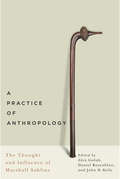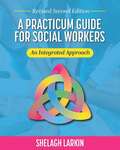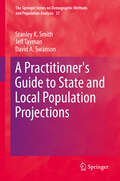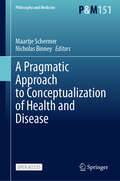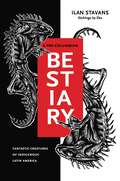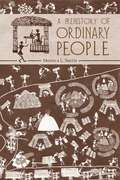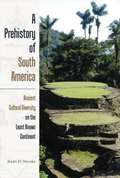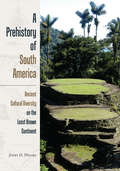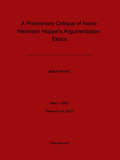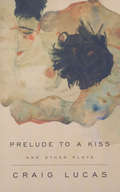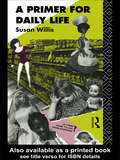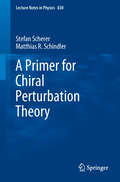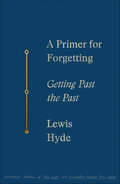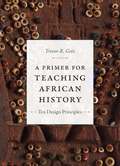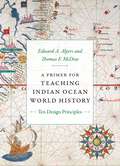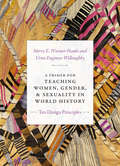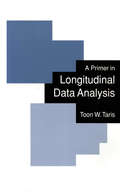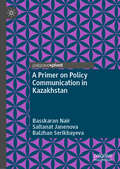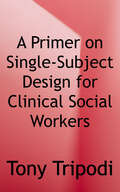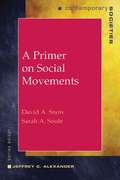- Table View
- List View
A Practice of Anthropology: The Thought and Influence of Marshall Sahlins
by John D. Kelly Alex Golub Daniel RosenblattMarshall Sahlins (b. 1930) is an American anthropologist who played a major role in the development of anthropological theory in the second half of the twentieth century. Over a sixty-year career, he and his colleagues synthesized trends in evolutionary, Marxist, and ecological anthropology, moving them into mainstream thought. Sahlins is considered a critic of reductive theories of human nature, an exponent of culture as a key concept in anthropology, and a politically engaged intellectual opposed to militarism and imperialism. This collection brings together some of the world’s most distinguished anthropologists to explore and advance Sahlins’s legacy. All of the essays are based on original research, most dealing with cultural change - a major theme of Sahlins’s research, especially in the contexts of Fijian and Hawaiian societies. Like Sahlins’s practice of anthropology, these essays display a rigorous, humanistic study of cultural forms, refusing to accept comfort over accuracy, not shirking from the moral implications of their analyses. Contributors include the late Greg Dening, one of the most eminent historians of the Pacific, Martha Kaplan, Patrick Kirch, Webb Keane, Jonathan Friedman, and Joel Robbins, with a preface by the late Claude Levi-Strauss. A unique volume that will complement the many books and articles by Sahlins himself, A Practice of Anthropology is an exciting new addition to the history of anthropological study.
A Practicum Guide for Social Workers: An Integrated Approach
by Shelagh LarkinA Practicum Guide for Social Workers grounds readers in a conceptualization of practice that considers the history and evolution of the profession with a specific emphasis on social work education and practicum. Throughout this thoroughly updated text, author Shelagh Larkin emphasizes context, "doing," mentorship with faculty and practicum supervisors, professional development of self, critical thinking, and the conscious and deliberate integration of practicum experiences and classroom learning. This book's pedagogy includes guided reflection questions and integrative activities (IAs) as well as suggested practicum tasks connected to each chapter. Many of the chapters also contain a frequently experienced situation (FES) feature that present common experiences that students have year after year. Among the updates from the previous edition, Larkin incorporates the new Council on Social Work Education, Educational Policies and Accreditation Standards (EPAS) 2022 throughout, integrates anti-racist practice, and strengthens the human rights component. A valuable resource on how to navigate the world of the classroom and the world of practice simultaneously, this book is geared toward Bachelor in Social Work (BSW) students who are in their junior or senior practicum courses and Master of Social Work (MSW) foundation students.
A Practitioner's Guide to State and Local Population Projections (The Springer Series on Demographic Methods and Population Analysis #37)
by David A. Swanson Stanley K. Smith Jeff TaymanThis book focuses on the methodology and analysis of state and local population projections. It describes the most commonly used data sources and application techniques for four types of projection methods: cohort-component, trend extrapolation, structural models, and microsimulation. It covers the components of population growth, sources of data, the formation of assumptions, the development of evaluation criteria, and the determinants of forecast accuracy. It considers the strengths and weaknesses of various projection methods and pays special attention to the unique problems that characterize small-area projections. The authors provide practical guidance to demographers, planners, market analysts, and others called on to construct state and local population projections. They use many examples and illustrations and present suggestions for dealing with special populations, unique circumstances, and inadequate or unreliable data. They describe techniques for controlling one set of projections to another, for interpolating between time points, for sub-dividing age groups, and for constructing projections of population-related variables (e. g. , school enrollment, households). They discuss the role of judgment and the importance of the political context in which projections are made. They emphasize the "utility" of projections, or their usefulness for decision making in a world of competing demands and limited resources. This comprehensive book will provide readers with an understanding not only of the mechanics of the most commonly used population projection methods, but also of the many complex issues affecting their construction, interpretation, evaluation, and use.
A Practitioners' Tool for Child Protection and the Assessment of Parents
by Jeff FowlerA practical tool for the assessment of children and their families, this guide enables professionals to make informed decisions about child protection issues. Firmly rooted in current practice, it draws on the expertise of a practising consultant and experienced qualified social worker Jeff Fowler, whose work has already formed the basis of guidance reports for child protection agencies and court proceedings. Providing detailed checklists for collecting and interpreting information vital to a best practice assessment, it also includes practical sections that focus on assessing attachment issues, childhood experiences, alcohol and drug abuse, and parenting skills and abilities. It presents a central case study leading to an assessment report which can be used for case conferences, as a core assessment in care proceedings, or for statements in public and private law matters. This is a helpful tool for anyone undertaking assessments but also for others who may be involved in aspects of child protection work such as social workers, health professionals, teachers, and legal and criminal justice professionals.
A Pragmatic Approach to Conceptualization of Health and Disease (Philosophy and Medicine #151)
by Maartje Schermer Nicholas BinneyThis open access book is an integrated historical and philosophical investigation of several problematic situations that emerge from diverse areas of medical practice. These include (but are not limited to): Paying less attention to patients who are suffering with symptoms because no identifiable pathological lesion or pathophysiological process can be found. Paying too much attention to patients who are not suffering with symptoms because pathological lesions or pathophysiological processes have been found. The tendency to understand patients at risk of developing pathology as being diseased. The tendency to disregard the importance of wider societal consequences of definitions of disease and health. The book shows that many of these problems are related to what disease and health are considered to be and argues that these problems can be addressed by reconsidering the concepts of health and disease employed in practice. It argues for a pragmatic reconceptualization of health and disease that allows clinicians, researchers, and lay people to understand health and disease in many ways, depending on the specific context in which they find themselves and the problems they are trying to solve. In doing so, authors are careful to show how this pragmatism does not endorse “silly” forms of relativism, in which knowledge is reduced to belief or to whatever people find expedient to believe. This work is relevant for philosophers and historians a well as for doctors, health policy makers and other health professionals because it addresses problems sourced from medical practice, albeit using philosophical and historical methods.
A Pre-Columbian Bestiary: Fantastic Creatures of Indigenous Latin America
by Ilan StavansAn encyclopedic collaboration between award-winning Mexican American scholar Ilan Stavans and illustrator Eko, A Pre-Columbian Bestiary features lively and informative descriptions of forty-six religious, mythical, and imaginary creatures from the Nahua, Aztec, Maya, Tabasco, Inca, Aymara, and other cultures of Latin America.From the siren-like Acuecuéyotl and the water animal Chaac to the class-conscious Oc and the god of light and darkness Xólotl, the magnificent entities in this volume belong to the same family of real and invented creatures imagined by Dante, Franz Kafka, C. S. Lewis, Jorge Luis Borges, Umberto Eco, and J. K. Rowling. They are mined from indigenous religious texts, like the Popol Vuh, and from chronicles, both real and fictional, of the Spanish conquest by Diego Durán, Bernal Díaz del Castillo, and Fernando de Zarzamora, among others. In this playful compilation, Stavans distills imagery from the work of magic realist masters such as Juan Rulfo and Gabriel García Márquez; from songs of protest in Mexico, Guatemala, and Peru; and from aboriginal beasts in Jewish, Muslim, European, British, and other traditions. In the spirit of imaginative invention, even the bibliography is a mixture of authentic and concocted material.An inspiring record of resistance and memory from a civilization whose superb pantheon of myths never ceases to amaze, A Pre-Columbian Bestiary will delight anyone interested in the history and culture of Latin America.
A Pre-Columbian Bestiary: Fantastic Creatures of Indigenous Latin America
by Ilan StavansAn encyclopedic collaboration between award-winning Mexican American scholar Ilan Stavans and illustrator Eko, A Pre-Columbian Bestiary features lively and informative descriptions of forty-six religious, mythical, and imaginary creatures from the Nahua, Aztec, Maya, Tabasco, Inca, Aymara, and other cultures of Latin America.From the siren-like Acuecuéyotl and the water animal Chaac to the class-conscious Oc and the god of light and darkness Xólotl, the magnificent entities in this volume belong to the same family of real and invented creatures imagined by Dante, Franz Kafka, C. S. Lewis, Jorge Luis Borges, Umberto Eco, and J. K. Rowling. They are mined from indigenous religious texts, like the Popol Vuh, and from chronicles, both real and fictional, of the Spanish conquest by Diego Durán, Bernal Díaz del Castillo, and Fernando de Zarzamora, among others. In this playful compilation, Stavans distills imagery from the work of magic realist masters such as Juan Rulfo and Gabriel García Márquez; from songs of protest in Mexico, Guatemala, and Peru; and from aboriginal beasts in Jewish, Muslim, European, British, and other traditions. In the spirit of imaginative invention, even the bibliography is a mixture of authentic and concocted material.An inspiring record of resistance and memory from a civilization whose superb pantheon of myths never ceases to amaze, A Pre-Columbian Bestiary will delight anyone interested in the history and culture of Latin America.
A Prehistory of Ordinary People
by Monica SmithFor the past million years, individuals have engaged in multitasking as they interact with the surrounding environment and with each other for the acquisition of daily necessities such as food and goods. Although culture is often perceived as a collective process, it is individual people who use language, experience illness, expend energy, perceive landscapes, and create memories. These processes were sustained at the individual and household level from the time of the earliest social groups to the beginnings of settled agricultural communities and the eventual development of complex societies in the form of chiefdoms, states, and empires.
A Prehistory of South America
by Jerry D. MooreA Prehistory of South America is an overview of the ancient and historic native cultures of the entire continent of South America based on the most recent archaeological investigations. This accessible, clearly written text is designed to engage undergraduate and begining graduate studens in anthropology. For more than 12,000 years, South American cultures ranged from mobile hunters and gatherers to rulers and residents of colossal cities. In the process, native South American societies made advancements in agriculture and economic systems and created great works of art-in pottery, textiles, precious metals, and stone-that still awe the modern eye. Organized in broad chronological periods, A Prehistory of South America explores these diverse human achievements, emphasizing the many adaptations of peoples from a continent-wide perspective. Moore examines the archaeologies of societies across South America, from the arid deserts of the Pacific coast and the frigid Andean highlands to the humid lowlands of the Amazon Basin and the fjords of Patagonia and beyond.Illustrated in full color and suitable for an educated general reader interested in the Precolumbian peoples of South America, A Prehistory of South America is a long overdue addition to the literature on South American archaeology.
A Prehistory of South America: Ancient Cultural Diversity on the Least Known Continent
by Jerry D. MooreA Prehistory of South America is an overview of the ancient and historic native cultures of the entire continent of South America based on the most recent archaeological investigations. This accessible, clearly written text is designed to engage undergraduate and beginning graduate students in anthropology. For more than 12,000 years, South American cultures ranged from mobile hunters and gatherers to rulers and residents of colossal cities. In the process, native South American societies made advancements in agriculture and economic systems and created great works of art—in pottery, textiles, precious metals, and stone—that still awe the modern eye. Organized in broad chronological periods, A Prehistory of South America explores these diverse human achievements, emphasizing the many adaptations of peoples from a continent-wide perspective. Moore examines the archaeologies of societies across South America, from the arid deserts of the Pacific coast and the frigid Andean highlands to the humid lowlands of the Amazon Basin and the fjords of Patagonia and beyond. Illustrated in full color and suitable for an educated general reader interested in the Precolumbian peoples of South America, A Prehistory of South America is a long overdue addition to the literature on South American archaeology.
A Preliminary Critique of Hans-Hermann Hoppe's Argumentation Ethics
by Adam KnottA critique of Hans-Hermann Hoppe's argumentation ethics from the point of view of Misesian praxeology.
A Preliminary Study on the New Normal of China's Economy (Research Series on the Chinese Dream and China’s Development Path)
by Jun WangThis book shows a panorama of sustainable development practices covering 70 major cities. This book has created the analysis framework of the “New Normal” of China’s economy, demonstrated the features and connotation of the "New Normal", carried out in-depth analysis and systematic study on the connotation and extension of the “New Normal” of China’s economy from ten aspects including growth shift, structural upgrading, innovation drive, regional synergy, moderate inflation, reform bonus, opening-up forced, risk exposure, sustainable development and macro-control in details and proposed targeted policy suggestions with practical application value that adapt to the new normal of China's economy and ensure the sustained, steady and healthy operation of the macro-economy.
A Prelude to a Kiss and Other Plays
by Craig LucasThis collection brings back into print one of Craig Lucas' best known and enduring works, A Prelude to a Kiss, which was both a hit on Broadway and a popular motion picture. Frank Rich in The New York Times wrote about Prelude, "It is rare to find a play so suffused with sorrow that sends one home so high." Also included are Missing Persons, "a truly intelligent play, one that is literary and heartfelt, beautifully written...a well-crafted, moving story, a dramatic rarity in these or any times "(New York Post), and Three Postcards, an offbeat and uniquely imaginative free form musical play.Craig Lucas is also the author of Reckless and Blue Window and What I Mean Was. He lives in Putnam Valley, New York.
A Primer For Daily Life (Studies in Culture and Communication)
by Susan WillisFirst published in 1991. Routledge is an imprint of Taylor & Francis, an informa company.
A Primer On Crime And Delinquency Theory
by Robert M. Bohm Brenda L. VogelThis slim volume offers a comprehensive survey of the major criminological and delinquency theories, including their philosophical foundations, policy implications, empirical support, and criticisms. A PRIMER ON CRIME AND DELINQUENCY THEORY can be used as a primary text or as a supplement for other texts, anthologies, or collections of journal articles.
A Primer for Chiral Perturbation Theory (Lecture Notes in Physics #830)
by Stefan Scherer Matthias R. SchindlerChiral Perturbation Theory, as effective field theory, is a commonly accepted and well established working tool, approximating quantum chromodynamics at energies well below typical hadron masses. This volume, based on a number of lectures and supplemented with additional material, provides a pedagogical introduction for graduate students and newcomers entering the field from related areas of nuclear and particle physics. Starting with the the Lagrangian of the strong interactions and general symmetry principles, the basic concepts of Chiral Perturbation Theory in the mesonic and baryonic sectors are developed. The application of these concepts is then illustrated with a number of examples. A large number of exercises (81, with complete solutions) are included to familiarize the reader with helpful calculational techniques.
A Primer for Forgetting: Getting Past the Past
by Lewis Hyde“One of our true superstars of nonfiction” (David Foster Wallace), Lewis Hyde offers a playful and inspiring defense of forgetfulness by exploring the healing effect it can have on the human psyche. We live in a culture that prizes memory—how much we can store, the quality of what’s preserved, how we might better document and retain the moments of our life while fighting off the nightmare of losing all that we have experienced. But what if forgetfulness were seen not as something to fear—be it in the form of illness or simple absentmindedness—but rather as a blessing, a balm, a path to peace and rebirth? A Primer for Forgetting is a remarkable experiment in scholarship, autobiography, and social criticism by the author of the classics The Gift and Trickster Makes This World. It forges a new vision of forgetfulness by assembling fragments of art and writing from the ancient world to the modern, weighing the potential boons forgetfulness might offer the present moment as a creative and political force. It also turns inward, using the author’s own life and memory as a canvas upon which to extol the virtues of a concept too long taken as an evil. Drawing material from Hesiod to Jorge Luis Borges to Elizabeth Bishop to Archbishop Desmond Tutu, from myths and legends to very real and recent traumas both personal and historical, A Primer for Forgetting is a unique and remarkable synthesis that only Lewis Hyde could have produced.
A Primer for Teaching African History: Ten Design Principles (Design Principles for Teaching History)
by Trevor R. GetzA Primer for Teaching African History is a guide for college and high school teachers who are teaching African history for the first time, for experienced teachers who want to reinvigorate their courses, for those who are training future teachers to prepare their own syllabi, and for teachers who want to incorporate African history into their world history courses. Trevor R. Getz offers design principles aimed at facilitating a classroom experience that will help students navigate new knowledge, historical skills, ethical development, and worldviews. He foregrounds the importance of acknowledging and addressing student preconceptions about Africa, challenging chronological approaches to history, exploring identity and geography as ways to access historical African perspectives, and investigating the potential to engage in questions of ethics that studying African history provides. In his discussions of setting goals, pedagogy, assessment, and syllabus design, Getz draws readers into the process of thinking consciously and strategically about designing courses on African history that will challenge students to think critically about Africa and the discipline of history.
A Primer for Teaching Indian Ocean World History: Ten Design Principles (Design Principles for Teaching History)
by Edward A. Alpers Thomas F. McDowA Primer for Teaching Indian Ocean World History is a guide for college and high school educators who are teaching Indian Ocean histories for the first time or who want to reinvigorate their courses. It can also serve those who are training future teachers to prepare their own syllabi, as well as those who want to incorporate Indian Ocean histories into their world history courses. Edward A. Alpers and Thomas F. McDow offer course design principles that will help students navigate topics ranging from empire, geography, slavery, and trade to mobility, disease, and the environment. In addition to exploring non-European sources and diverse historical methodologies, they discuss classroom pedagogy and provide curriculum possibilities that will help instructors at any level enrich and deepen standard approaches to world history. Alpers and McDow draw readers into strategically designing courses that will challenge students to think critically about a vast area with which many of them are almost entirely unfamiliar.
A Primer for Teaching Women, Gender, and Sexuality in World History: Ten Design Principles (Design Principles for Teaching History)
by Merry E. Wiesner-Hanks Urmi Engineer WilloughbyA Primer for Teaching Women, Gender, and Sexuality in World History is a guide for college and high school teachers who are teaching women, gender, and sexuality in history for the first time, for experienced teachers who want to reinvigorate their courses, for those who are training future teachers to prepare their own syllabi, and for teachers who want to incorporate these issues into their world history classes. Merry E. Wiesner-Hanks and Urmi Engineer Willoughby present possible course topics, themes, concepts, and approaches while offering practical advice on materials and strategies helpful for teaching courses from a global perspective in today's teaching environment for today's students. In their discussions of pedagogy, syllabus organization, fostering students' historical empathy, and connecting students with their community, Wiesner-Hanks and Willoughby draw readers into the process of strategically designing courses that will enable students to analyze gender and sexuality in history, whether their students are new to this process or hold powerful and personal commitments to the issues it raises.
A Primer in Longitudinal Data Analysis
by Toon W Taris`The author has done a remarkable job of writing a very accessible introduction to a broad literature. As such, he should be congratulated on achieving his objective to provide the "ideal primer for this growing area of social research"' - Kwantitatieve Methoden This accessible introduction to the theory and practice of longitudinal research takes the reader through the strengths and weaknesses of this kind of research, making clear: how to design a longitudinal study; how to collect data most effectively; how to make the best use of statistical techniques; and how to interpret results. Although the book provides a broad overview of the field, the focus is always on the practical issues arising out of longitudinal research. This book supplies the student with all that they need to get started and acts as a manual for dealing with opportunities and pitfalls. It is the ideal primer for this growing area of social research.
A Primer of GIS, Second Edition
by Francis HarveyThis accessible text prepares students to understand and work with geographic information systems (GIS), offering a detailed introduction to essential theories, concepts, and skills. The book is organized in four modular parts that can be used in any sequence in entry-level and more specialized courses. Basic cartographic principles are integrated with up-to-date discussions of GIS technologies and applications. Coverage includes everything from what geographic information is to its many uses and societal implications. Practical examples and exercises invite readers to explore the choices involved in producing reliable maps and other forms of geographic information. Illustrations include 170 figures (with 15 in color). The companion website provides links to Web resources for each chapter, plus downloadable PowerPoint slides of most of the figures. New to This Edition *Chapter on online mapping and Big Data. *New and updated discussions of remote sensing, vector and raster data models, location privacy, uses of geocoding, and other timely topics. *Chapter on the many uses of GIS, such as in market analyses, emergency responding, and tracking of epidemics. *Section overviews and an end-of-book glossary. Pedagogical Features *Modules and individual chapters can be used sequentially or in any order. *End-of-chapter review questions with answers, exercises, and extended exercises for applying theories and concepts. *"In-Depth" sidebars offering a closer look at key concepts and applications. *End-of-chapter links to relevant Web resources.
A Primer on Policy Communication in Kazakhstan
by Basskaran Nair Saltanat Janenova Balzhan SerikbayevaThis book is a timely publication to address the issue of the government’s policy execution capabilities. The crux of policy execution is communication to win the hearts and minds of the people, particularly with regard to complex policies. The book is written as a work manual based on international policy communication best practices and principles, interwoven with case studies from Kazakhstan, applicable in other Central Asian countries as well. The book’s wide range of topics cover media management in a technologically-savvy society, marketing of complexity, planning successful campaigns, soft power management given the country’s aspirations for greater international standing, and forward-looking advice on crisis management and shareholder communication. This is a highly relevant book for the civil service, civic organisations, commercial entities, policy researchers, and international organisations working in or planning to work in Kazakhstan and other Central Asian countries.
A Primer on Single-Subject Design for Clinical Social Workers
by Tony TripodiThe move to managed care in the human services has increased the popularity of single-subject design -- an adaptable methodology that is information based, outcome oriented, and consumer driven. <p><p>Special Features: Contains 39 tables and 55 figures; Demonstrates how clinicians can use the model to monitor treatment effectiveness; Promotes accountability in clinical practice.
A Primer on Social Movements (Contemporary Societies Series)
by Sarah A. Soule David A. SnowAward-winning sociologists David Snow and Sarah Soule draw from a broad range of theories including political sociology, theories of organizations, and the study of culture and social interaction to introduce the essential ideas for analyzing social movements.
